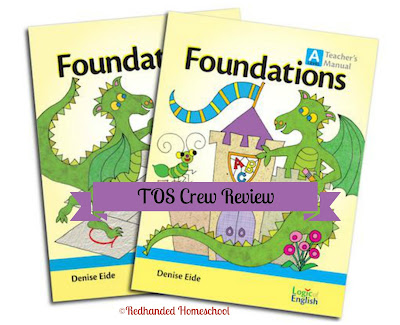Pssst. Part 1 of the seriously expanded 2nd edition of Essentials is just out now. Some of The Crew are reviewing that as well, so check them out. Link at the end of this post.
I wasn't the only excited person when the Foundations A box arrived at the house. Merrick was beside himself, opening the huge box of school goodies! We had to start right away.
This is what we received:
- Foundations A Teacher's Manual
- Level A Student Workbook*
- Doodling Dragons ABC Book
- Phonogram and Spelling Quick Reference
- Rhythm of Handwriting Quick Reference Chart*
- Rhythm of Handwriting Tactile Cards*
- Phonogram Game Cards*
- Lined Whiteboard
- Basic Phonogram Flash Cards
- Phonogram Game Tiles
- Spelling Analysis Card
 |
| Opening his treasures |
The hardcover Teacher's Manual is over 210 pages. Each of the 40 regular lessons and eight review lessons is scripted for parents who like that. Personally, I love that for some subjects and this is definitely one of those times I prefer it. There are plenty of boxes in the sidebar loaded with teacher tips, book recommendations, and activities related to the lessons. In lesson 25, your child will make his or her first reader. The pages are in the back of the workbook and they can either use the illustrations in the workbook or draw their own.
 |
| Workbook and Teacher's Manual |
 |
| Reader pages |
I've actually been in the progress of making tactile alphabet cards, but the only precut burlap letters I could find were uppercase (of course!) and DIY sand paper letters seem so work intensive, so I had put that project on hold for now. Happily, tactile cards came with the program! The cards are 4.25"x6" which makes them a tad smaller than LOE's phonogram and other assorted cards. I am keeping the tactile cards in with the big kids' cards, but I quickly realized I'm in serious need of a larger box!
 |
| He's not a lefty, but every once in a while he just prefers that hand. |
Doodling Dragons: An ABC Book of Sounds is a nicely illustrated ABC book with a twist. Rather than the typical "A is for apple" page, each two page spread shows examples of all the sounds made by the letters. It's fun to read and fun to look at. Sadly, our copy went for a walk somewhere in this house and I've yet to find it again.
This curriculum is loaded with activities to reinforce the lessons. Merrick is a very busy guy and he was able to spend part of each day doing something active. Even the listening parts often incorporated activities. He played Simon Says games and games that involve listening to the sounds in a word, figuring out what the word is, and doing the activity. Here, he is playing a ball game. Each time he was a good listener and was able to "glue" the parts of a word together and tell it to me, he was allowed to throw the ball into a basket. Of course, BooBear had to play too!
We've actually used the Basic Phonogram Cards with the bigger littles already. This card pack teaches the 74 basic phonograms of the English language. The sturdy cards are a large size. One side shows the letter or phonogram and the other lists the sound(s) it makes, *in the order of frequency,* and examples of words using each of the sounds. With this deck, 98% of English words can be decoded.
The Phonogram Game Card decks are in use here also, though we haven't gotten to them in Foundations A. Mal's favorite game is Dragon. Two decks are recommended for some of the card games, like dragon, go fish, and memory. These decks are much smaller than the flash card decks. They are available in cursive, manuscript, and bookface. They include phonogram cards and game-type cards like rotten egg, draw 2, and snatch it. These cards come in a variety of typefaces.
The Phonogram Game Tiles are very sturdy cardstock phonograms used for spelling words. They're perforated tiles and easy to separate. The single and multi-letter vowels are red, consonants are blue, silent Es are green, and bossy R vowels are purple. You might notice in this picture that the Y tiles come in red and blue because sometimes Y is a vowel and sometimes not.
There is nothing I've ever gotten from Logic of English that I haven't been incredibly pleased with. Every single component is high quality. I'd recommend Foundations for beginning and struggling readers. This is a complete phonics, reading, and writing curriculum for little ones. If your gang is a little older (seven and up), Essentials would probably be the way to go.
Find The Logic of English on social media.
YouTube







No comments:
Post a Comment